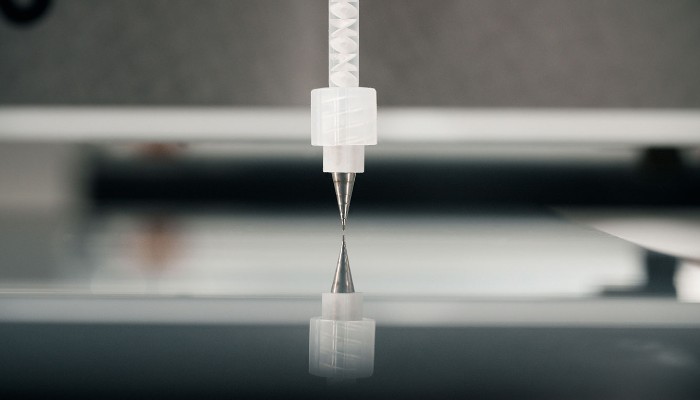
Seals play a vital role in many fields. Notably, seals are used to prevent or reduce the leakage or ingress of liquids, gases or solid substances such as dust. To be effective, they need to be plastic and elastically malleable, chemically resistant, resistant to temperature and aging, and wear-resistant. One material that is therefore a suitable material for seals is silicone rubber, an elastomer consisting of silicone, hydrogen, carbon and oxygen. In the injection molding process, silicone rubber is used in its liquid form, but this material could not be used for 3D printing. However, thanks to InnovativQ’s LiQ320 3D printer, which is based on the Liquid Additive Manufacturing process, this is no longer the case. With the LiQ320, it is possible for the first time to use liquid injection molding silicone for industrial 3D printing.
How does LiQ320’s Liquid Additive Manufacturing process work?
Liquid Additive Manufacturing is, as the name suggests, an additive manufacturing process for liquids and viscous materials, such as liquid silicone rubber. Like any AM process, it begins with the creation of a 3D model. For this, CAD data is converted for the programming software and the parameters are optimized. Afterwards, the final data is transferred to the LiQ320 3D printer. When the printing process starts, the LiQ320 begins volumetric material extrusion. The material consists of two components that are mixed in the printhead. Thanks to the printhead technology, precise metering and an ideal mixing ratio are possible, so that the structure buildup in the object can be controlled at the molecular level. Additionally, because of the Open Material Platform, the user is not tied to a specific manufacturer’s material.

The printhead technology enables precise metering and an ideal mixing ratio, so that the application direction and thus the crosslinking can be influenced at the molecular level. (photo credits: InnovatiQ)
Similar to the FDM process, the material is applied to the print bed layer by layer by the extruder. In contrast, the starting material is already in liquid form and does not have to be melted first. Additionally, each individual layer is cured during the printing process with the help of a high-temperature halogen lamp (approx. 2,000 watts), which thermally cross-links the material.
This thermal crosslinking can be influenced and controlled with pinpoint accuracy. For example, overhangs can be generated by crosslinking the material very quickly and consistently. In contrast, to generate glassy structures, the crosslinking process is only started at the end of the printing process and crosslinked very softly. Another advantage of this thermal crosslinking is that the printing time is considerably reduced. When the printing process is complete, the object can be removed and used directly without post-processing.
Liquid Additive Manufacturing is suitable for prototypes, individual objects and small-scale industrial production. The range of applications extends from the automotive industry to medical technology. Seals are particularly interesting application, as they are used in many different industries.

The high-temperature halogen lamp cures the individual layers, thermally crosslinking the material. (photo credits: InnovatiQ)
Printing liquid silicone gaskets
As already mentioned, seals have diverse uses. For example, they can be used in the construction industry as window seals, door seals or insulation, but also in the electrical industry to protect electronic components from extreme heat, salt, corrosion and contamination. Their shapes are correspondingly diverse, both in terms of size and complexity.
Particularly in the electrical industry, the need for small, complex seals is growing, ones that can be made in smaller batches. With the injection molding process, it is difficult to respond flexibly and quickly to such requirements, since the appropriate mold first has to be manufactured. This also means additional costs, meaning that small batches are not profitable.
Liquid Additive Manufacturing eliminates these lead times and set-up costs, allowing companies to respond quickly to requirements and adapt to ever shorter innovation cycles. At the same time, the technical properties remain comparable to injection molded parts with almost any geometric shape. In addition, it is possible to print the seal directly onto an existing component. To do this, the component is placed in the printer, the seal made of liquid silicone rubber is applied and cured directly during the printing process thanks to thermal crosslinking. A finished component can be removed that is ready for immediate use. In the video you can see different seals that have been produced using Liquid Additive Manufacturing.


